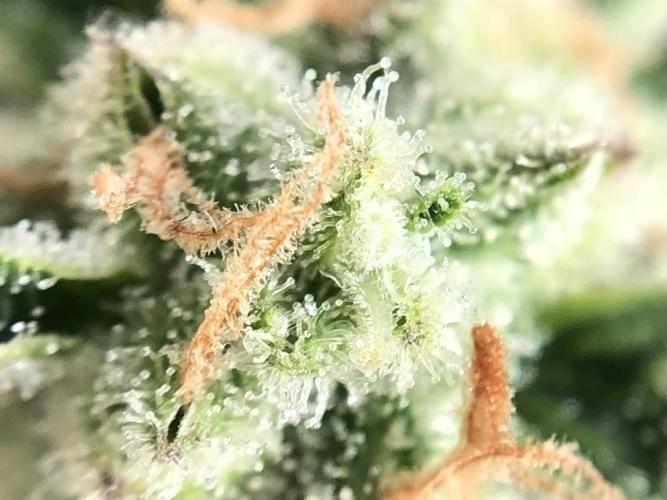The Grow Awards 2026 🏆 













Monitoring pH?
JinksyGrowsanswered grow question 6y ago
Mousey! Pleasure to see you👍. I hear you on the pH pens. I actually like mine (Milwaukee brand), but it does take constant calibration... and that's annoying. What I've been turning too more and more are just my manual pH tests. Not only do I know they're dead accurate, but I use it to prove that my digital pH meter isn't out of whack. Example: Tested with pH pen, came back at 6.2. Did my manual as a checks and balance and it came back orange! or roughly 5ish pH. Meter was effed and if I didn't do the manual I would have done serious damage.
I guess my final answer is this. Do both if you can, for checks and balances. I'd keep the pH pen if it's quality (what brand? is it just not a good pen?) and go purchase yourself the GHE pH tester kit. It's a cheap solution, lasts for a looooong time (only 4 drops needed per test) and is deadly accurate. Metals or additives that may screw up you digital tester will not be able to do this with the manual pH litmus testing. Doesn't have to be GHE, it can be an equivalent as they're pretty much all the same. I suggest staying away from litmus papers for testing and stick with the vial and liquid testing agent. I'll link you the product in PM real quick, just going to source it quickly. Heads up that the price is in CDN and I'm in Canada, but this is available everywhere...literally, even Amazon, for cheap👍👍
Crazyweedptanswered grow question 6y ago
Other Ways to Test Soil
While a pH tester can come handy, gardening experts also recommend other unique ways to evaluate the quality of the soil. For instance, if you would like to test for alkaline, here is what you need to do:
Dig about six inches deep and take a soil sample.
Remove any debris from the soil and make sure that only soil remains. If there are clumps, break them before you proceed with the test.
Place one cup of the soil in a glass container.
Add water and mix the soil until it becomes muddy.
Add a half cup of vinegar and mix.
At this point, if there are bubbles, this is an indication of alkaline in the soil.
From the steps that have been mentioned above, if the bubbles did not form, proceed to another test, which will help you to determine if the soil is acidic.
From the portion of the garden where you retrieved the soil that has been initially tested, get another one cup and place in a glass container.
Add water and mix until it becomes muddy.
This time, instead of using vinegar, you have to put baking soda. Stir.
If there are bubbles, this shows that the soil is acidic. If nothing happens after testing for both alkaline and acid, this means that you have a neutral soil.
However, while these are great alternatives, I suggest that you still use a pH tester kit. After all, there is no substitute for the real thing if you want the results to be more accurate.
likes
Complain
CRiSPrGrowanswered grow question 6y ago
hey man, i know it feels like school or a toy or something, but i did prefer using pH strips for a while. you can actually find some with 0.1 precision. No calibration, doesnt break, it's cheap and it works instantly... what's not to like?
likes
Complain
Fruitgroweranswered grow question 6y ago
It's the only way mate unless you grow back to d soil then it doesn't matter so much (although it's still important) I'm very lucky my two water comes out at 6.5 I rarely test it. 🌱✌️👍
1 like
Complain
Vincent11answered grow question 6y ago
Hi Mousey
I personally have a machine for different types off alkaline water.
From 2.5 to 11 PH.
We are using it for drinking 9.5PH water my whole family healthy water healthy life.
And my marijuana plants love the 6 PH water I am feeding them with.
I am sure that after I add nutrition she goes up to 6.4.
But plants love it.
Machine Enagic Kangen k8
I check run off with a digital pen or my simple cheap Flower care monitor.
Both work good.
And are quite reliable. When I compare both they give me similar measurements.
Good luck with your grows.
Happy Growing
1 like
Complain
HighRoller909answered grow question 6y ago
pens man.paper kits are sometimes confusing,not very accurate for me.I have a cheap ph meter and it works really good,since 2017
2 likes
Complain
Similar Grow Questions
Solved

AirDuster
Help in understanding instrument readings for hydroI'd like to undertand what the importance or significance of these numbers are, and if they indicate issues to resolve:
Hydro - 30 litre reservoir
ph: 5.91 - pretty sure that's in the perfect range for hydro
ppm 1502 - no idea
μS/cm - 3195 - no idea
humidity 41%
Temp: 21 - 36c5y ago
4
4
Solved

versace_grow
Hi everyone, I would like to ask you how you test Temperature and RH. Do you put your thermometer under the direct light at the base of the plants or inderectly, because I have pretty different values . If I put it under the light my temperature is near 35°C and RH is under 20%Setup. Sensors
6y ago
2
5
Solved

Minnesota_Grows_420
CO2 meter suggestionsSuggestions on a decent reasonably priced CO2 meter? ThanksWeek 2
Setup. Sensors
2y ago
2
2
Solved

AirDuster
Reducing PPM without changing water in hydroThanks all for guidance on my previous question. As a follow up, can PPM be lowered by reducing feeding until they hit the right range? Currently 1500ppm but seems this is too high. Currently following the AdvancedNutrients plan.Other. General questions
Setup. Sensors
Feeding. Schedule
5y ago
3
4
Solved

I_T_C_R_W___GROW
perfekt small grow - what is needed? What a perfekt light needs or should have?What features should a universal Growbox have ?
And what a perfekt light (for a 50x50cm Area in this box ) must have- for seed / settling/grow/& bloom & maintaince like holding a Mother near endless? Can you all help me to build the perfect diy box?2mo ago
1
3
Solved

russrahl
Can I use Smart Water to mix up ph powder calibration solutions?Cant find deionized water where I live to mix up my ph powder solutions and be confident they are correct. I used generic distilled water before but later realized it was not neutral at 7.0 ph. So long story short google says Smart Water is 6.98 ph, Think I can use it instead?
Week 7
Setup. Sensors
5y ago
2
2
Solved

ItalianDesertBalcony
Are these photos good enough?Should I invest in a stronger lense clip for my cell phone or are these photos clear enough to judge harvest time?
Buds. Other
Plant. Other
Setup. Sensors
2mo ago
1
6
Solved

Puffdamagikchillum
Hygrometer with probeWhat is everyone buying for a Hygrometer with probe?Setup. Sensors
6y ago
3
3
Solved

Lala_grows
pH Pen Calibration Frequency?How often should I re-calibrate my PH pen? I have a cheap Milwaukee pH600 and after 3 months of use it had drifted enough to cause real damage (was reading 5.8 when chemical drops read ~4.0). Alternatively, is there a reasonably priced option that would avoid this?Week 12
Setup. Sensors
2y ago
3
3
Solved

versace_grow
RH 90% during Flowering!I have a problem with RH. I am at the 3rd week of Flowering and I'm struggling to keep my RH down. Today it was 90% when I opened the grow box. I have access only to a window. Is it better to suck air inside or blow the exhausted air out? I can't do bothSetup. Sensors
Setup. Ventilation
6y ago
2
3
Solved

Mooncat
EC/PPM Values for SoilI just bought some EC/PPM Meter and cant find some Chart about the right values for growing in Soil...i know how and so on but yeah.Setup. Sensors
Feeding. Other
5y ago
3
Solved

fartsimpson
What should be plugged into the digital timer?Currently, I have the timer plugged into the wall outlet, then to the powerstrip, but this doesn't seem feasible. I have lights, exhaust, fan, and humidifier connected to the powerstrip, so everything shuts off when the timer is off. Is this the norm?Week 1
Setup. Sensors
6y ago
2
2




















